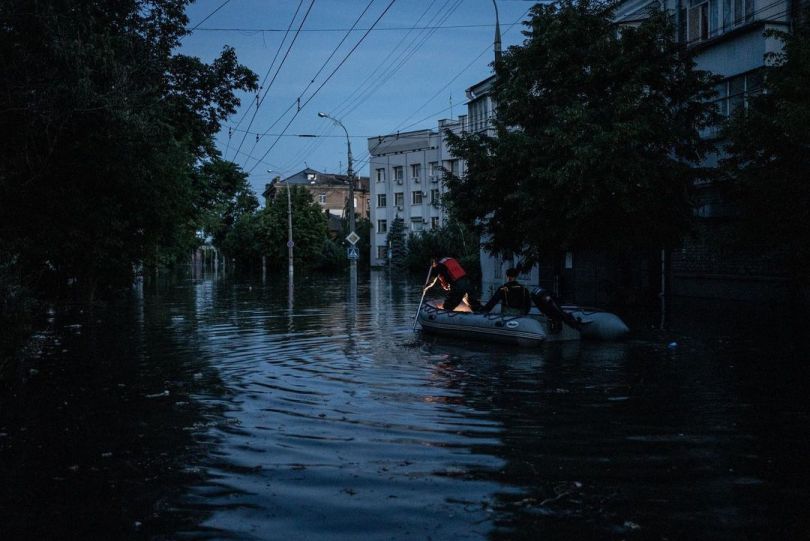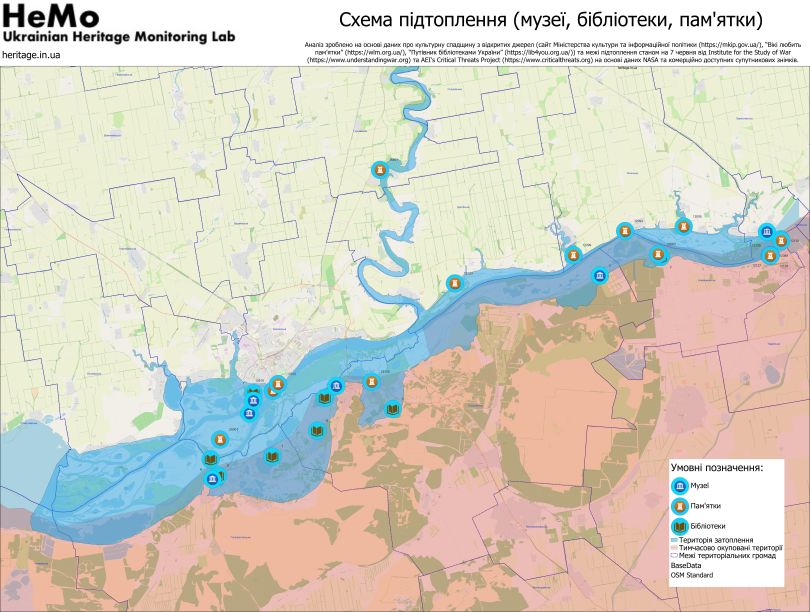Dozens of populated areas have been flooded, hectares of agricultural and nature reserve lands have been destroyed, and many domestic and wild animals, freshwater fish, and birds have perished. Water bodies and drinking water sources have been contaminated over a vast territory. Dozens of cultural heritage sites have been destroyed, and there are casualties among the population. It is currently impossible to calculate all the losses as it requires time and, at the very least, access to all affected territories, some of which are still occupied.
The largest man-made catastrophe of recent decades is already being called Ukraine's ecocide, and it will undoubtedly impact the state of the world's ecosystems, which is even more significant in the context of global climate change. Therefore, the joint mitigation of the consequences is an urgent and critical task for the worldwide community, including environmentalists, scientists, international organizations, and countries' governments.
However, the situation is further complicated because the catastrophe occurred in a conflict zone. Moreover, there have already been shelling by forces occupying aid centers for the affected, volunteers, and ordinary people trying to evacuate from the occupied territories. The occupying authorities failed to organize the evacuation and hindered local volunteers and rescuers from the controlled territories of Ukraine in assisting the affected.
The terror of water and shelling continues. All of this demands attention and reaction from the world.
Consequences of the explosion of the Kahovka Hydroelectric Power Station
The man-made catastrophe caused by Russia will have irreparable humanitarian, social, economic, epidemiological, and environmental consequences - this is the consensus among various experts providing preliminary assessments.

People and Territories
520 square kilometers flooded, dozens of populated areas submerged, thousands of people evacuated, and tens of thousands of Ukrainians were left homeless. There are reports of fatalities and missing persons, but obtaining precise data on the casualties of the attack is impossible, partly since some of the flooded territories are under occupation and/or still submerged.
As of June 13, 2023, 30 populated areas in the Kherson and 31 in the Mykolaiv regions remain flooded, as reported by the Prime Minister of Ukraine, Dmytro Shmyhal. He also mentioned that 3,700 citizens have already evacuated.
As a result of the devastation of the Kahovka reservoir, many populated areas will be left without water, including major industrial cities such as Kryvyi Rih. This could lead to production stoppages, unpaid wages, and tax arrears. Consequently, unemployment, a decrease in the standard of living, and social tensions may occur
Environment
A large amount of fuel and lubricants (150 tons on the first day), as well as toxic waste from cesspools and settling tanks, have entered the water. This has already led to contamination of water bodies and drinking water sources. Pollutants are also reaching the Black Sea. There is a high risk of increased infectious diseases and a worsening epidemiological situation in the region.
Alexander Krasnolutsky, the First Deputy Minister of Environmental Protection and Natural Resources of Ukraine, noted that hundreds of thousands of birds and tens of thousands of animals, including a significant number of endangered flora and fauna species, are at risk of extinction.
30% of the nature reserve fund is at risk of disappearing due to the flood. The Nyzhnedniprovske National Park has been completely submerged, resulting in the destruction of 120 valuable plant and animal species protected by law. Flooded areas include typical and rare floodplain forests, swamps, meadows, sandy steppes, and gullies that were preserved prior to the catastrophe. The famous Oleshky Sands, a true Ukrainian desert, is also under the threat of complete disappearance as they are currently under occupation.
The flooding has a catastrophic impact on fish resources. The Kahovka reservoir was home to the largest number of freshwater industrial fish species in Ukraine, and as a result, the losses to the fishing industry could reach 95,000 tons, equivalent to approximately 4 billion hryvnias. Furthermore, a portion of the freshwater fish will end up in the Black Sea, where they will perish.
Assessing all the environmental consequences is currently challenging, but experts agree that this is a problem that will persist for decades, and they predict that the changes will be irreversible. For more information about the environmental consequences, please read here.
Agriculture
Thousands of hectares of agricultural land in Kherson and Mykolaiv regions have been submerged. Andriy Kravchenko, the Deputy Director of the Department of Agricultural Development at the Ministry of Agrarian Policy and Food, stated that the flooding of 1,300 hectares of farmland in the Kherson region has been confirmed so far, with a potential threat of flooding for an additional 25,000 hectares. However, it is still too early to provide exact figures.
There will also be the re-swamping of previously drained lands in the lower reaches of the Dnieper River, soil degradation due to erosion caused by the tidal wave, and silting, among other consequences.
Furthermore, due to the drying up of the Kahovka reservoir, 31 irrigation systems in Dnipropetrovsk, Kherson, and Zaporizhzhia regions will lose their water supply, leaving 94% of irrigation systems in Kherson, 74% in Zaporizhzhia, and 30% in Dnipropetrovsk without water. Consequently, the southern regions will face drought, and farmers will be unable to cultivate grain, fruit, and vegetable crops, leading to shortages and price increases in Ukraine and globally. This will significantly impact the economic situation in the region and the country.
The full economic consequences for the country are yet to be calculated, but the costs will amount to billions of euros.
Cultural Heritage
The HeMo Ukrainian Heritage Monitoring Lab, in collaboration with the Smithsonian Cultural Rescue Initiative, has collected preliminary data on the flooding of cultural heritage sites. The summarized data is as follows: 5 museums have been submerged, including writer Ostap Vyshnya's memorial house and Polina Raiko's painted house, a vibrant example of naive art. Ten libraries, 15 architectural sites, and six archaeological sites have also been affected.

The team's preliminary report can be viewed here.
The Reaction of the International Community
In the first days following the terrorist attack, over 40 world leaders made clear statements regarding the catastrophe, placing blame for the explosion of the Kakhovka Hydroelectric Power Station dam on the occupying forces. Despite Russia's information attack, which attempted to shift blame onto Ukraine and caused chaos in the information space, world leaders remained consistent and unequivocal in their assessments.
Ursula von der Leyen, President of the European Commission, stated, "Russia must be held accountable for the war crimes committed in Ukraine. The destruction of the dam and this outrageous attack on civilian infrastructure put thousands of people in the Kherson region at risk. Europe is mobilizing assistance through our Civil Protection Mechanism. We coordinate with member countries to quickly deliver pumps, fire hoses, and boats with mobile water purification stations. We will stand with Ukraine for as long as necessary."
As of June 13, 13 countries have joined the relief efforts, as Ukrainian Prime Minister Denys Shmyhal announced. He stated, "We are talking about dozens and hundreds of boats, rafts, motor pumps, generators, containers, tanks, water filters, and many other things."
The catastrophe caused by Russia has shocked the world. It has sparked a new wave of support from governments, organizations, and ordinary citizens in various European and global countries. People are collecting humanitarian aid, organizing events and rallies to draw attention to the disaster. In most major cities in Switzerland, for example, people took to the streets with posters saying "Russia - a country of terrorists," "Stop EcoGenocide in Ukraine," and others. People are raising funds and gathering humanitarian aid to send to Ukrainians.
The new global crime committed by Russia has evoked outrage, sympathy, and a strong desire to help the Ukrainian people.
Informational Hygiene by Timothy Snyder
Renowned American historian Timothy Snyder, a professor at Yale University who consistently supports Ukraine, has written a column titled "The Kakhovka Reservoir Dam: Ten Tips on Writing about the Catastrophe to Counter Russian Disinformation and Support Ukraine."
"Avoid the temptation to start the narrative about this man-made humanitarian and ecological catastrophe with 'considering both sides' perspectives.' That's not journalism," he noted. "Presenting Russian statements alongside Ukrainian ones is unfair to Ukrainians. In this war, what Russian spokespeople said was almost always untrue, while Ukrainian spokespeople mostly spoke the truth. Comparing the viewpoints of both sides assumes their equality, which prevents readers from understanding this crucial difference."
He also emphasized that Russia controlled the relevant part of the dam when it exploded. "This is an essential part of the context," he emphasized. "It outweighs what someone said. When investigating a murder, detectives think about the murder weapon. In Russia, they had it. Ukraine did not."
Furthermore, Timothy continued, this story does not begin with the dam explosion. Readers should know that over the past 15 months, Russia has been killing Ukrainian civilians and destroying Ukrainian civil infrastructure while Ukraine has been trying to protect its people and the infrastructure that sustains their lives.
.jpg)
As a summary:
The tragedy caused by the actions of Russian forces has led to increased international support for Ukraine, particularly in the context of flood relief. All Ukrainians are immensely grateful for this. However, this is only part of the task facing the world. Environmental organizations worldwide and international structures must be involved in addressing the global ecological problems caused by the dam explosion, as it is a worldwide issue.
A long-term plan is needed to minimize the negative consequences of the catastrophe and restore everyday life to the region.
It is equally important to do everything possible to prevent similar terrorist acts by Russia in the future. In particular, the Zaporizhia Nuclear Power Plant, also located in the occupied territory, is at risk. Its cooling system relied to some extent on the Kakhovka Reservoir. There is enough water in the cooling pools for another 4-5 weeks. Of course, alternative water supply sources have been planned, but the occupying authorities who destroyed the hydroelectric power plant must make the decision and efforts regarding their implementation. An accident at the nuclear power plant could be another crime by Russian occupying forces against the planet.
Therefore, the world, including international organizations, must respond urgently, mobilizing all possible resources. Awareness of this is our most important task right now.







